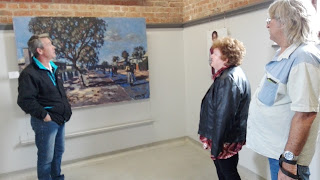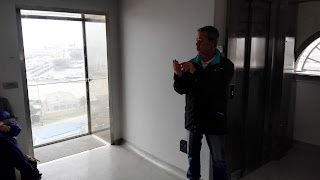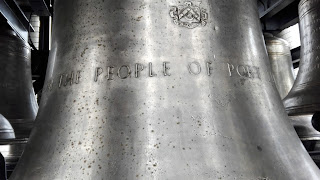peter.giddy@gmail.com
In association with SA Guided tours
petergiddy@saguidedtours.com
Contact Peter for a unique City and Historical Tour in Port Elizabeth
September 2017
The Campanile of Port Elizabeth (an adaption of Florentine architecture). 50m high with 204 steps winding up to the 7th floor. It is built on a site that is as close as possible to the original landing site of the Settlers of 1820. There were originally 23 bells and in 2017, an additional two have been added to allow for a wider range of sounds.
The design for the Campanile was approved on 10 March 1922, and the contract for building the structure was subsequently awarded on 18 march 1922 to a local firm of builders, Harris and Harrower Limited, whose tender was £6 150.
July 1936 carried a long-awaited announcement concerning the bells. During the intervening years only £850 had been available for the purpose of installing bells. This was the year, however, when all the British Empire was celebrating the Silver Jubilee (25th Anniversary) of King George V and the installation of the desired carillon seemed a fitting expression of gratitude for the sovereign's memorable reign.
The citizens of Port Elizabeth rallied to the occasion with the same persevering spirit exhibited by the early Settlers they were honouring. The steady growth of funds and generous contribution from the City Council, ultimately enabled the municipality to obtain the bells from Gillett and Johnston Limited. These bells, with a gross weight of over 16 tons, comprise one of the largest carillons in South Africa
September 2017
Peter takes guests to the newly refurbished, at a cost of a reported R18 Mil, Bell Tower in Port Elizabeth. -- Otherwise known as the Campanile (Italian). This tower was built at the entrance to the PE Harbour in 1920 and completed 1923 to celebrate the arrival of the British Settlers who arrived in the Cape Colony in 1820
Following the end of the Napoleonic Wars there was high unemployment in England and so free passage and a portion of land was given to 4000 settlers.
Today I meet Deon and Jackie from Cape Town who had won a City Tour at a Getaway show that they attended. So we start off at the Campanile where we are treated to a first class tour with Leigh a MBDA Engineer who was part of the refurbishment of the Bell Tower completed this month.
Leigh talks about the Art Gallery -- an opportunity for people to display their work. Jackie and Deon.
Look Carfully... This is a Step. on the bottom left hand corner is a 67. This remembers Mandela's 67 years of service given to South Africa.
The old Clappers have been preserved and are numbered here on display to be seen and touched. If you look closely (when you visit) you may notice that the clappers have worn on the side which struck the bell. This means that an uneven sound is produced as the clapper is designed to strike with the smallest surface as is the case when the clapper is new and completely round.
Leigh gives us all the background and information about the bells, the lift that has been installed, the first three floors are an art gallery, the 67th step is there to remember Nelson Mandela's 67 years of service to RSA.
Facing to the South
This observation window is a new addition and allows visitors to stand "outside" the Campanile.
Facing to the East
Inside the observation room just below where the Bells are located
Facing Northwards
Facing Westwards
He explains the electronic operations of the bells. He shows us the old Clappers. He shows us the hydraulic systems of how the bells are rung. Everything is electronic and can be controlled with his Cell Phone from basically anywhere in the world where he has internet connection.
Bells of different sizes and with donor information
Made by ..... and Johnston; Croydon England; 1936
The bells and the clappers... Driven by a pneumatic system
Donated by the Cuyler family
We take the lift to the 7th floor and are able to look out of the Observation window for a view of N S E & W of the city centre. We then listen as the bells strike 12 and then two minutes later they play the National Anthem of SA.
Glass replica of the Bells. There are two new bells. These are indicated with red lights. The Campanile is lit up at night and plays different colours to the tunes.
The bells can be lit manually by visitors on this keyboard.
We visit the room where there are glass replica of the Bells. These are lit and controlled from a Piano and are a toy for the amusement of visitors.
A player piano (also known as pianola) is a self-playing piano, containing a pneumatic or electro-mechanical mechanism that operates the piano action via pre-programmed music recorded on perforated paper, or in rare instances, metallic rolls, with more modern implementations using MIDI. The rise of the player piano grew with the rise of the mass-produced piano for the home in the late 19th and early 20th century. Sales peaked in 1924, then declined as the improvement in phonograph recordings due to electrical recording methods developed in the mid-1920s. The advent of electrical amplification in home music reproduction via radio in the same period helped cause their eventual decline in popularity, and the stock market crash of 1929 virtually wiped out production.
The old clock mechanism saved from being trashed
Here you see the inside of the clock on top as well as the pendulum of the clock below.
The clock hands have to be balanced with counter weights to prevent them "falling down" when the 1 or 2 o'clock is reached.
And the room where the Clock Mechanisms are situated. Leigh explains how the Clocks are set and run on an electronic system that checks on the internet by GPS co ordinates and calculates the exact time. There is a pendulum that weighs the mechanism down and then resets with a electric pulley. And should the back up battery fail then the electronics will recalculate the time and reset it automatically.
The structure of the building has been solidified and each brick examined and, if necessary has been chipped out and refilled. Plus a lift has been installed to allow for people who are not able to climb stairs.
A visit to the Campanile is an essential part of the Historical City Tour of Port Elizabeth.
A Carillon is a musical instrument that is typically housed in a Bell Tower (Campanile or Belfry) and consists of at least 23 cup shaped bells.
King George V Carillon
The bells of this Carillon were given by the persons and institutions hereunder named
1. Reverend Bishop Macsherry -- In Memory of the Irish Settlers of 1820 and after.
2. Mr & Mrs Craig Bain In loving memory of Phyllis Craig Bain who was called to God on 24 August 1935 aged 21 years old.
3. The Royal Society of St George (Womens branch) --- In Gratitude to the 25 years of glorious reign of George V from the Royal Society of St George Womens branch of Port Elizabeth.
4. Adcock Family -- To the memory of Christopher Adcock and his wife Elizabeth Sarah who voyaged to Port Elizabeth in 1820 on board the SS Ocean with the British Settlers. By the Adcock Family.
5. Hayward Family -- John James Hayward (28th Januarie, 1859) in Liefdevolle Erkendlikheid geskenk deur sy kinders; George, Philip, John, WIllie, Jocaba, Anna en Piet.
6. Newcombe Family -- In memory of Robert Newcombe 1782 - 1862. 1820 Settlers. Parkin Party.
7. The Scottish Association. -- To the memory of the Scotsmen who have lived and laboured in this city since 1920. Port Elizabeth Scottish association.
8. Mrs Harrower and Cecil. -- In memorty of JH Harrower whose firm built this Campanile from his widow and son Cecil.
9. Mr Harrower -- To the memory of Mr Smith Hudson who served this city for 15 years as a councillor ; Donated by his daughter .. Mrs JH Harrower.
10. Richardson Family -- In loving memory of Lewis Richardson. 1875 - 1934. This bell is given by the Richarson Family.
11. Mr DA Mc Laren. -- In memory of the Merchants of Port Elizabeth held in Honourable regard all over South Africa.
12. Mr Victor T Jones -- In Memory of Dr William John Burchell; 1782 to 1865. Explorer and Father of this city. Presented by Victor T Jones.
13. Mr H H Whitcher. - "REX" From HH Whitcher
14. The descendants of the Hobson Family. To commemorate the landing of our forbears -- David and Carey Hobson in 1820.
15. Anonymous. In loving memory of CF Cayser (Member of Parliament)
16. Mc Williams family. -- John and Isabella Mc Williams 1831 - 1915 and 1844 - 1926.
17. Mr John Pyott and his family. -- Donated by Mr and Mrs John Pyott and family of this city in greatful (should read Grateful) acknowledgement of 54 years happiness and success in South Africa.
18. The Jewish Community. -- Presented by the Jewish Citizens of Port Elizabeth as a token of respect for a wise and good king and to commemorate the reign of his late Majesty, King George V
19. City Council. Colonel Jacob Cuyler.
20. City Council. Frederick Korsten
21. The Women of Port Elizabeth. Sir Rufane and Lady Elizabeth Donkin who gave her name to this city. From the women of Port Elizabeth.
22. Trust Fund. -- Captain Francis Evatt
23. .............................. From the people of
Supplied and Erected by Messrs Gillett and Johnson
The strike mechanism, manufactured by that fine old English firm of clockmakers and bellfounders, Gillett and Johnston Limited of Croydon, Surrey, was installed during 1936 when the bells were hung.
Additional history of Port Elizabeth and related matters.
Early in 1913, a competition was held for architects' plans for a new Grey High School building and Boarding House in Mill Park, Port Elizabeth. The designs produced by Jones and McWilliams were chosen as the most suitable. The Imposing Grey High School and Boarding House, which were completed in 1915, were built in the traditional Cape Dutch idiom and the composition of the buildings are aesthetically pleasing. Both buildings were designed to be in harmony with each other, and are linked by a cloister. The school building is wholly dependent on the prominent voluted concavo gables, dignified central clock tower, shuttered windows, colonaded porticoes and shaped parapets for its beauty.
During his architectural career McWilliams used classical styles with great competence and adopted the shape of an Italian renaissance campanile for the memorial to the British Settlers.
- Queen Victoria reigned 1837 to 1901 -- 63 years.
- Edward V11 reigned 1901 to 1910 -- See the King Edward Hotel opposite the Donkin Memorial Site.
- George V Reigned 1910 to 1936 -- The bells of the Campanile are dedicated to George V who visited South Africa in 1901.... And so we have Kings beach; St Georges Park and Cricket Ground;
- Edward V111 Reigned Jan 1936 to December 1936 when he abdicated following his proposal of marriage to divorcee Wallis Simpson. Eldest son of George V
- George V1 -- Reigned from December 1936 to 1952. Second son of George V. Wife was Elizabeth the Queen Mother.
- Elizabeth 11 -- Reigns 1952 to present (2017 = 65 years and is now the longest reigning monarch) Married to Prince Philip.
George V (George Frederick Ernest Albert; 3 June 1865 – 20 January 1936) was King of the United Kingdom and the British Dominions, and Emperor of India, from 6 May 1910 until his death in 1936.
He was the second son of the Prince of Wales (later King Edward VII), and grandson of the then reigning British monarch, Queen Victoria. From the time of his birth, he was third in the line of succession behind his father and his own elder brother, Prince Albert Victor, Duke of Clarence and Avondale. From 1877 to 1891, George served in the Royal Navy, until the unexpected death of his elder brother in early 1892 put him directly in line for the throne. On the death of his grandmother in 1901, George's father became King-Emperor of the British Empire, and George was created Prince of Wales. He succeeded his father in 1910. He was the only Emperor of India to be present at his own Delhi Durbar.
His reign saw the rise of socialism, communism, fascism, Irish republicanism, and the Indian independence movement, all of which radically changed the political landscape. The Parliament Act 1911 established the supremacy of the elected British House of Commons over the unelected House of Lords. As a result of the First World War (1914–1918), the empires of his first cousins Tsar Nicholas II of Russia and Kaiser Wilhelm II of Germany fell, while the British Empire expanded to its greatest effective extent. In 1917, George became the first monarch of the House of Windsor, which he renamed from the House of Saxe-Coburg and Gotha as a result of anti-German public sentiment. In 1924 he appointed the first Labour ministry and in 1931 the Statute of Westminster recognised the dominions of the Empire as separate, independent states within the Commonwealth of Nations. He had smoking-related health problems throughout much of his later reign and at his death was succeeded by his eldest son, Edward VIII.
Victoria (Alexandrina Victoria; 24 May 1819 – 22 January 1901) was Queen of the United Kingdom of Great Britain and Ireland from 20 June 1837 until her death. From 1 May 1876, she adopted the additional title of Empress of India.
Victoria was the daughter of Prince Edward, Duke of Kent and Strathearn, the fourth son of George III of the United Kingdom. Both the Duke of Kent and King George III died in 1820, and Victoria was raised under close supervision by her German-born mother, Princess Victoria of Saxe-Coburg-Saalfeld. She inherited the throne at the age of 18, after her father's three elder brothers had all died, leaving no surviving legitimate children. The United Kingdom was already an established constitutional monarchy, in which the sovereign held relatively little direct political power. Privately, Victoria attempted to influence government policy and ministerial appointments; publicly, she became a national icon who was identified with strict standards of personal morality.
Victoria married her first cousin, Prince Albert of Saxe-Coburg and Gotha, in 1840. Their nine children married into royal and noble families across the continent, tying them together and earning her the sobriquet "the grandmother of Europe". After Albert's death in 1861, Victoria plunged into deep mourning and avoided public appearances. As a result of her seclusion, republicanism temporarily gained strength, but in the latter half of her reign her popularity recovered. Her Golden and Diamond Jubilees were times of public celebration.
Her reign of 63 years and seven months is known as the Victorian era and was longer than that of any of her predecessors. It was a period of industrial, cultural, political, scientific, and military change within the United Kingdom, and was marked by a great expansion of the British Empire. She was the last British monarch of the House of Hanover. Her son and successor, Edward VII, inaugurated the House of Saxe-Coburg and Gotha, the line of his father.





















No comments:
Post a Comment